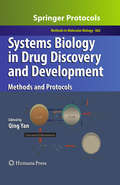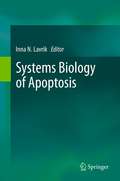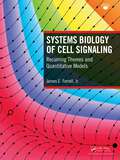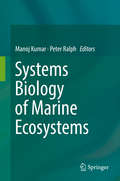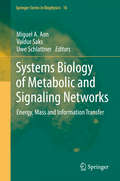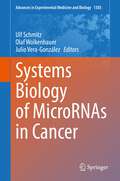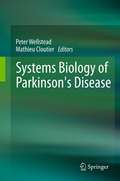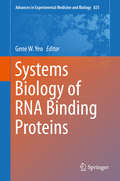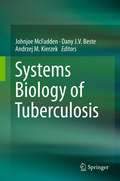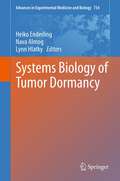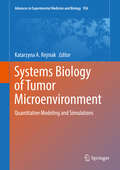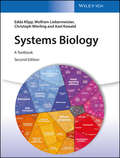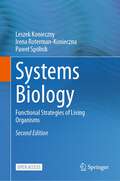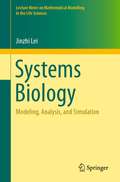- Table View
- List View
Systems Biology in Drug Discovery and Development: Methods and Protocols
by Qing YanDue to the failing "one-drug-fits-all" model, it has become increasingly necessary to develop personalized medicine that treats whole systems and brings the right drug to the right patient with the right dosages. In Systems Biology in Drug Discovery and Development: Methods and Protocols, leading experts provide a practical, state-of-the-art, and holistic view of the translation of systems biology into better drug discovery and personalized medical practice. While the first part of the book describes cutting-edge technologies and methods in the field, the second part illustrates how the technologies can be applied in science for disease understanding and therapeutic discovery. As a volume in the highly successful Methods in Molecular BiologyTM series, this collection provides the kind of detailed description and implementation advice that is crucial for getting optimal results. Authoritative and up-to-date, Systems Biology in Drug Discovery and Development: Methods and Protocols covers topics from fundamental concepts to advanced technologies in order to best serve biomedical students and professionals at all levels who are interested in vital integrative studies in molecular biology, genetics, bioinformatics, bioengineering, biochemistry, physiology, pathology, microbiology, immunology, pharmacology, toxicology, drug discovery, and clinical medicine.
Systems Biology of Apoptosis
by Inna N. LavrikSystems Biology of Apoptosis summarizes all current achievements in this emerging field. Apoptosis is a process common to all multicellular organisms. Apoptosis leads to the elimination of cells via a complex but highly defined cellular programme. Defects in the regulation of apoptosis result in serious diseases such as cancer, autoimmunity, AIDS and neurodegeneration. Recently, a substantial step forward in understanding the complex apoptotic pathways has been made by utilising systems biology approaches. Systems biology combines rigorous mathematical modelling with experimental approaches in a closed loop cycle for advancing our knowledge about complex biological processes. In this book, the editor describes the contemporary systems biology studies devoted to apoptotic signaling and focuses on the question how systems biology helps to understand life/death decisions made in the cell and to develop new approaches to rational treatment strategies.
Systems Biology of Cell Signaling: Recurring Themes and Quantitative Models
by James FerrellHow can we understand the complexity of genes, RNAs, and proteins and the associated regulatory networks? One approach is to look for recurring types of dynamical behavior. Mathematical models prove to be useful, especially models coming from theories of biochemical reactions such as ordinary differential equation models. Clever, careful experiments test these models and their basis in specific theories. This textbook aims to provide advanced students with the tools and insights needed to carry out studies of signal transduction drawing on modeling, theory, and experimentation. Early chapters summarize the basic building blocks of signaling systems: binding/dissociation, synthesis/destruction, and activation/inactivation. Subsequent chapters introduce various basic circuit devices: amplifiers, stabilizers, pulse generators, switches, stochastic spike generators, and oscillators. All chapters consistently use approaches and concepts from chemical kinetics and nonlinear dynamics, including rate-balance analysis, phase plane analysis, nullclines, linear stability analysis, stable nodes, saddles, unstable nodes, stable and unstable spirals, and bifurcations. This textbook seeks to provide quantitatively inclined biologists and biologically inclined physicists with the tools and insights needed to apply modeling and theory to interesting biological processes.Key Features: Full-color illustration program with diagrams to help illuminate the concepts Enables the reader to apply modeling and theory to the biological processes Further Reading for each chapter High-quality figures available for instructors to download
Systems Biology of Marine Ecosystems
by Manoj Kumar Peter RalphThis book describes the latest advances in systems biology in four plant-based marine ecosystems: seaweeds, seagrasses, microalgae, and corals. Marine organisms that inhabit the oceanic environment experience a diverse range of environmental fluctuations, anthropogenic stress, and threats from invasive species and pathogens. System biology integrates physiology, genomics, transcriptomics, proteomics, and metabolomics into numerical models and is emerging as an important approach to elucidate the functional adaptations of marine organisms to adverse environmental conditions. This book focuses on how ecophysiology, omics platforms, their integration (a systems biology perspective), and next generation sequencing tools are being used to address the stress response of marine seaweeds, seagrasses, corals, marine microbe diversity, and micro-and macroalgae/corals-bacterial interactions to global climate change and anthropogenic activities. The contents of the book are of special interest to graduate and postgraduate marine biology students and marine biology researchers, particularly those interested in marine ecology, stress physiology of marine macrophytes/corals/phytoplankton, and environmental microbiology. This book would also be of interest to marine engineers engaged in the management and conservation of our valuable marine resources.
Systems Biology of Metabolic and Signaling Networks
by Miguel A. Aon Valdur Saks Uwe SchlattnerSystems Biology represents a new paradigm aiming at a whole-organism-level understanding of biological phenomena, emphasizing interconnections and functional interrelationships rather than component parts. The study of network properties, and how they control and regulate behavior from the cellular to organism level, constitutes a main focus of Systems Biology. This book addresses from a novel perspective a major unsolved biological problem: understanding how a cell works and what goes wrong in pathology. The task undertaken by the authors is in equal parts conceptual and methodological, integrative and analytical, experimental and theoretical, qualitative and quantitative, didactic and comprehensive. Essentially, they unravel the spatio-temporal unfolding of interacting mass-energy and information networks at the cellular and organ levels, as well as its modulation through activation or repression by signaling networks to produce a certain phenotype or (patho)physiological response. Starting with the historical roots, in thirteen chapters this work explores the Systems Biology of signaling networks, cellular structures and fluxes, organ and microorganism functions. In doing so, it establishes the basis of a 21st century approach to biological complexity.
Systems Biology of MicroRNAs in Cancer (Advances in Experimental Medicine and Biology #1385)
by Ulf Schmitz Olaf Wolkenhauer Julio Vera-GonzálezThis book provides an update on the latest development in the field of microRNAs in cancer research with an emphasis on translational research. Since the early 2000s, microRNAs have been recognized as important and ubiquitous regulators of gene expression. Soon it became evident that their deregulation can cause human diseases including cancer. This book focuses on the emerging opportunities for the application of microRNA research in clinical practice. In this context, computer models are presented that can help to identify novel biomarkers, e.g. in circulating microRNAs, and tools that can help to design microRNA-based therapeutic interventions. Other chapters evaluate the role of microRNAs in immunotherapy, immune responses and drug resistance. Covering key topics on microRNAs in cancer research this book is a valuable resource for both emerging and established microRNA researchers who want to explore the potential of microRNAs as therapeutic targets or co-adjuvants in cancer therapies.
Systems Biology of Parkinson's Disease
by Mathieu Cloutier Peter WellsteadThe Systems Biology of Parkinson's Disease will be underpinned by new measurement techniques. This is particularly true of the pathology of Parkinson's Disease, where recent developments in brain imaging have offered new insights into the morphology of dopaminergic neurons that have profound implications for the special vulnerability and role of this class of neurons.
Systems Biology of RNA Binding Proteins
by Gene W. YeoAfter transcription in the nucleus, RNA binding proteins (RBPs) recognize cis-regulatory RNA elements within pre-mRNA sequence to form mRNA-protein (mRNP) complexes. Similarly to DNA binding proteins such as transcription factors that regulate gene expression by binding to DNA elements in the promoters of genes, RBPs regulate the fate of target RNAs by interacting with specific sequences or RNA secondary structural features within the transcribed RNA molecule. The set of functional RNA elements recognized by RBPs within target RNAs and which control the temporal, functional and spatial dynamics of the target RNA define a putative "mRNP code". These cis-regulatory RNA elements can be found in the 5' and 3' untranslated regions (UTRs), introns, and exons of all protein-coding genes. RNA elements in 5' and 3' UTRs are frequently involved in targeting RNA to specific cellular compartments, affecting 3' end formation, controlling RNA stability and regulating mRNA translation. RNA elements in introns and exons are known to function as splicing enhancers or silencers during the splicing process from pre-mRNA to mature mRNA. This book provides case studies of RNA binding proteins that regulate aspects of RNA processing that are important for fundamental understanding of diseases and development. Chapters include systems-level perspectives, mechanistic insights into RNA processing and RNA Binding proteins in genetic variation, development and disease. The content focuses on systems biology and genomics of RNA Binding proteins and their relation to human diseases.
Systems Biology of Tuberculosis
by Dany J.V. Beste Johnjoe Mcfadden Andrzej M. KierzekThe book starts with a general introduction into the relevance of systems biology for understanding tuberculosis. This will be followed by several chapters which describe the application of systems biology to various aspects of the study of the pathogen, Mycobacterium tuberculosis, and its interaction with the host. The book provides the reader with an account of how the new science of systems biology is providing novel insights into the ancient scourge of tuberculosis. It will also describe how systems biology can be applied to the control of tuberculosis, including the development of new treatments, vaccines and diagnostics.
Systems Biology of Tumor Dormancy
by Heiko Enderling Nava Almog Lynn HlatkyThis volume is based on the Workshop on Systems Biology of Tumor Dormancy meeting, held July 25th to July 28th, 2011. The first annual CCSB workshop brought together biologists, clinicians, mathematicians, and computer scientists to discuss various aspects of tumor dormancy and develop novel mathematical/computational models with the keynote speakers. Specific topics included the angiogenic switch, immune system interactions, cancer stem cells and signaling.
Systems Biology of Tumor Microenvironment
by Katarzyna A. RejniakThis edited volume discusses the complexity of tumor microenvironments during cancer development, progression and treatment. Each chapter presents a different mathematical model designed to investigate the interactions between tumor cells and the surrounding stroma and stromal cells. The topics covered in this book include the quantitative image analysis of a tumor microenvironment, the microenvironmental barriers in oxygen and drug delivery to tumors, the development of tumor microenvironmental niches and sanctuaries, intravenous transport of the circulating tumor cells, the role of the tumor microenvironment in chemotherapeutic interventions, the interactions between tumor cells, the extracellular matrix, the interstitial fluid, and the immune and stromal cells. Mathematical models discussed here embrace both continuous and agent-based approaches, as well as mathematical frameworks of solid mechanics, fluid dynamics and optimal control theory. The topics in each chapter will be of interest to a biological community wishing to apply the mathematical methods to interpret their experimental data, and to a biomathematical audience interested in exploring how mathematical models can be used to address complex questions in cancer biology.
Systems Biology: A Textbook
by Christoph Wierling Axel Kowald Edda Klipp Wolfram Liebermeister Ralf HerwigThis advanced textbook is tailored for an introductory course in Systems Biology and is well-suited for biologists as well as engineers and computer scientists. It comes with student-friendly reading lists and a companion website featuring a short exam prep version of the book and educational modeling programs. The text is written in an easily accessible style and includes numerous worked examples and study questions in each chapter. For this edition, a section on medical systems biology has been included.
Systems Biology: Constraint-based Reconstruction and Analysis
by Bernhard O. PalssonRecent technological advances have enabled comprehensive determination of the molecular composition of living cells. The chemical interactions between many of these molecules are known, giving rise to genome-scale reconstructed biochemical reaction networks underlying cellular functions. Mathematical descriptions of the totality of these chemical interactions lead to genome-scale models that allow the computation of physiological functions. Reflecting these recent developments, this textbook explains how such quantitative and computable genotype-phenotype relationships are built using a genome-wide basis of information about the gene portfolio of a target organism. It describes how biological knowledge is assembled to reconstruct biochemical reaction networks, the formulation of computational models of biological functions, and how these models can be used to address key biological questions and enable predictive biology. Developed through extensive classroom use, the book is designed to provide students with a solid conceptual framework and an invaluable set of modeling tools and computational approaches.
Systems Biology: Functional Strategies of Living Organisms
by Irena Roterman-Konieczna Leszek Konieczny Paweł SpólnikThis open-access textbook is an excellent introduction to systems biology, which has developed rapidly in recent years. It discusses the processes in living organisms in an integrated way, enabling the reader to understand the fundamental principles and cause-effect relationships in biology and biochemistry. The authors have chosen an original but at the same time clear way of presenting the topics, repeatedly drawing comparisons and models from the macroscopic world and making the reader aware of the unity of the laws of physics, chemistry and biology. The fully updated 2nd edition also contains information that has only become available as a result of the increase in knowledge in recent years. This includes information on tumorigenesis, where significant progress has been made due to the explosive development of genetic knowledge as well as bioengineering with a highly effective technique adopted from the solutions of the bacterial world, such as CRISPR/CAS. This richly illustrated book is essential for postgraduate students and scientists of the following disciplines: biology, biotechnology, medicine, bioinformatics, robotics and automation, biocybernetics, and biomedical engineering. It is also an exciting read for anyone interested in biology.
Systems Biology: Modeling, Analysis, and Simulation (Lecture Notes on Mathematical Modelling in the Life Sciences)
by Jinzhi LeiThis book discusses the mathematical simulation of biological systems, with a focus on the modeling of gene expression, gene regulatory networks and stem cell regeneration. The diffusion of morphogens is addressed by introducing various reaction-diffusion equations based on different hypotheses concerning the process of morphogen gradient formation. The robustness of steady-state gradients is also covered through boundary value problems. The introduction gives an overview of the relevant biological concepts (cells, DNA, organism development) and provides the requisite mathematical preliminaries on continuous dynamics and stochastic modeling. A basic understanding of calculus is assumed. The techniques described in this book encompass a wide range of mechanisms, from molecular behavior to population dynamics, and the inclusion of recent developments in the literature together with first-hand results make it an ideal reference for both new students and experienced researchers in the field of systems biology and applied mathematics.
Systems Biology: Principles, Methods, and Concepts
by Andrzej K. KonopkaWith extraordinary clarity,the Systems Biology: Principles, Methods, and Concepts focuses on the technical practical aspects of modeling complex or organic general systems. It also provides in-depth coverage of modeling biochemical, thermodynamic, engineering, and ecological systems. Among other methods and concepts based in logic, computer
Systems Biomechanics of the Cell
by Ivan V. MalySystems Biomechanics of the Cell attempts to outline systems biomechanics of the cell as an emergent and promising discipline. The new field owes conceptually to cell mechanics, organism-level systems biomechanics, and biology of biochemical systems. Its distinct methodology is to elucidate the structure and behavior of the cell by analyzing the unintuitive collective effects of elementary physical forces that interact within the heritable cellular framework. The problematics amenable to this approach includes the variety of cellular activities that involve the form and movement of the cell body and boundary (nucleus, centrosome, microtubules, cortex, and membrane). Among the elementary system effects in the biomechanics of the cell, instability of symmetry, emergent irreversibility, and multiperiodic dissipative motion can be noted. Research results from recent journal articles are placed in this unifying framework. It is suggested that the emergent discipline has the potential to expand the spectrum of questions asked about the cell, and to further clarify the physical nature of animate matter and motion.
Systems Biomedicine Approaches in Cancer Research
by Shailza SinghThis book presents the applications of systems biology and synthetic biology in cancer medicine. It highlights the use of computational and mathematical models to decipher the complexity of cancer heterogeneity. The book emphasizes the modeling approaches for predicting behavior of cancer cells, tissues in context of drug response, and angiogenesis. It introduces cell-based therapies for the treatment of various cancers and reviews the role of neural networks for drug response prediction. Further, it examines the system biology approaches for the identification of medicinal plants in cancer drug discovery. It explores the opportunities for metabolic engineering in the realm of cancer research towards development of new cancer therapies based on metabolically derived targets. Lastly, it discusses the applications of data mining techniques in cancer research. This book is an excellent guide for oncologists and researchers who are involved in the latest cancer research.
Systems Chemical Biology: Methods and Protocols (Methods in Molecular Biology #1888)
by Herbert Waldmann Slava ZieglerThis volume explores the latest available wet-lab techniques and computational methods to study in-cell small-molecule behavior and interactions with their targets. The chapters in this book discuss topics such as disease-relevant models for chemical biology studies, target engagement using cellular thermal shift assay or bioluminescence resonance energy transfer; visualization of bio-active small molecules Raman microscopy; (phospho-)proteomics and transcriptomics for mode-of-action studies, CRISPR/Cas9-based chemogenomic profiling in mammalian cells; predicting drug interactions using computational approaches; comparison of compound-induced profiles using high-content imaging or cancer cell line panels and web-based tools for polypharmacology prediction. Written in the highly successful Methods in Molecular Biology series format, chapters include introductions to their respective topics, lists of the necessary materials and reagents, step-by-step, readily reproducible laboratory protocols, and tips on troubleshooting and avoiding known pitfalls. Cutting-edge and thorough, Systems Chemical Biology: Methods and Protocols is a valuable resource for novice or expert scientists and researchers trying to initiate or continue their chemical biology studies at a systems level.
Systems Concepts in Action: A Practitioner's Toolkit
by Bob Williams Richard HummelbrunnerSystems Concepts in Action: A Practitioner's Toolkit explores the application of systems ideas to investigate, evaluate, and intervene in complex and messy situations. The text serves as a field guide, with each chapter representing a method for describing and analyzing; learning about; or changing and managing a challenge or set of problems. The book is the first to cover in detail such a wide range of methods from so many different parts of the systems field. The book's Introduction gives an overview of systems thinking, its origins, and its major subfields. In addition, the introductory text to each of the book's three parts provides background information on the selected methods. Systems Concepts in Action may serve as a workbook, offering a selection of tools that readers can use immediately. The approaches presented can also be investigated more profoundly, using the recommended readings provided. While these methods are not intended to serve as "recipes," they do serve as a menu of options from which to choose. Readers are invited to combine these instruments in a creative manner in order to assemble a mix that is appropriate for their own strategic needs.
Systems Engineering and Analysis (Prentice Hall International Series in Industrial and Systems Engineering)
by Benjamin S. Blanchard Wolter J. Fabrycky<p>For senior-level undergraduate and first and second year graduate systems engineering and related courses. Systems Engineering and Analysis, 5/e, provides a total life-cycle approach to systems and their analysis. <p>This practical introduction to systems engineering and analysis provides the concepts, methodologies, models, and tools needed to understand and implement a total life-cycle approach to systems and their analysis. The authors focus first on the process of bringing systems into being—beginning with the identification of a need and extending that need through requirements determination, functional analysis and allocation, design synthesis, evaluation, and validation, operation and support, phase-out, and disposal. Next, the authors discuss the improvement of systems currently in being, showing that by employing the iterative process of analysis, evaluation, feedback, and modification, most systems in existence can be improved in their affordability, effectiveness, and stakeholder satisfaction.</p>
Systems Engineering in Context: Proceedings of the 16th Annual Conference on Systems Engineering Research
by William T. Scherer James H. Lambert Stephen Adams Peter A. Beling Cody H. FlemingThis volume chronicles the 16th Annual Conference on System Engineering Research (CSER) held on May 8-9, 2018 at the University of Virginia, Charlottesville, Virginia, USA. The CSER offers researchers in academia, industry, and government a common forum to present, discuss, and influence systems engineering research. It provides access to forward‐looking research from across the globe, by renowned academicians as well as perspectives from senior industry and government representatives. Co‐founded by the University of Southern California and Stevens Institute of Technology in 2003, CSER has become the preeminent event for researchers in systems engineering across the globe. Topics include though are not limited to the following: Systems in context: · Formative methods: requirements · Integration, deployment, assurance · Human Factors · Safety and Security Decisions/ Control & Design; Systems Modeling: · Optimization, Multiple Objectives, Synthesis · Risk and resiliency · Collaborative autonomy · Coordination and distributed decision-making Prediction: · Prescriptive modeling; state estimation · Stochastic approximation, stochastic optimization and control Integrative Data engineering: · Sensor Management · Design of Experiments
Systems Engineering: Analysis, Modeling and Simulation of Systems
by Emmanuel HygounencThis book is intended for students, teachers, researchers, engineers and project managers wishing to understand and implement systems engineering into their work. Based on numerous bibliographical sources, it provides coherent and accessible information, complemented with numerous illustrations. Systems Engineering will enable the reader to not only understand but also master the development cycle of a system, as well as gain an in-depth understanding of the associated terminology. An introduction to systems theory is presented first, clarifying what is meant by a complex system. The book then outlines systems engineering and one of its components: requirements engineering. A detailed presentation of the downhill activities of the development cycle follows the definition of requirements and the design of systems. Finally, the book explores the upstream activities of the development cycle with the virtual and concrete integration of the system.
Systems Engineering: Fundamentals and Applications (Engineering Systems Ser.)
by Reinhard Haberfellner Olivier de Weck Ernst Fricke Siegfried VössnerThis translation brings a landmark systems engineering (SE) book to English-speaking audiences for the first time since its original publication in 1972. For decades the SE concept championed by this book has helped engineers solve a wide variety of issues by emphasizing a top-down approach. Moving from the general to the specific, this SE concept has situated itself as uniquely appealing to both highly trained experts and anybody managing a complex project. Until now, this SE concept has only been available to German speakers. By shedding the overtly technical approach adopted by many other SE methods, this book can be used as a problem-solving guide in a great variety of disciplines, engineering and otherwise.By segmenting the book into separate parts that build upon each other, the SE concept’s accessibility is reinforced. The basic principles of SE, problem solving, and systems design are helpfully introduced in the first three parts. Once the fundamentals are presented, specific case studies are covered in the fourth part to display potential applications. Then part five offers further suggestions on how to effectively practice SE principles; for example, it not only points out frequent stumbling blocks, but also the specific points at which they may appear. In the final part, a wealth of different methods and tools, such as optimization techniques, are given to help maximize the potential use of this SE concept.Engineers and engineering students from all disciplines will find this book extremely helpful in solving complex problems. Because of its practicable lessons in problem-solving, any professional facing a complex project will also find much to learn from this volume.
Systems Engineering: Reliability Analysis Using k-out-of-n Structures
by Tadashi Dohi Mangey RamA substantial amount of research has been conducted on consecutive k-out-of-n and related reliability systems over the past four decades. These systems have been used to model various engineering systems such as the microwave stations of telecoms network, oil pipeline systems, and vacuum systems in an electron accelerator. As such, studies of reliability properties of consecutive k-out-of-n structures have attracted significant attention from both theoretical and practical approaches. In the modern era of technology, the redundancies are employed in the various industrial systems to prevent them from failure/sudden failure or to recover from failures. This book is meant to provide knowledge and help engineers and academicians in understanding reliability engineering by using k-out-of-n structures. The material is also targeted at postgraduate or senior undergraduate students pursuing reliability engineering.
